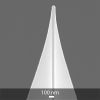Magnetic AFM Probes
Magnetic AFM probes are intended to be used for Magnetic Force Microscopy (MFM). For that purpose, their AFM tip is coated with a magnetic thin film creating a magnetic stray field that interacts with magnetic fields of the sample under investigation. Therefore, this technique allows high-resolution visualization of magnetic domains at the sample.
The measurement technique is usually based on dual surface scan. The first scan detects the surface topography in the same way as standard AFM applications would do. Afterwards the surface is scanned a second time but at a pre-defined distance to the surface (lift height). This second scan detects magnetic interactions between the magnetized AFM tip and the magnetic domains of the sample. The separation of information is achieved by using short-range mechanical forces for surface detection and long-range magnetic forces for visualization of magnetic domains.
Magnetic Force Microscopy is usually performed under ambient conditions although it can be done in vacuum or within liquids, as well. The samples under investigation need not be electrically conductive and sample preparation is not necessary. A thin cover layer protecting the magnetic layer has almost no impact on the measurement result. Applying an external field for modification of sample domains is possible, as well, as long as the AFM tip magnetization is not affected by the external field.
In order to facilitate this measurement mode, the magnetic AFM probes combine good force sensitivity with sufficient stability for dynamic mode operation. The AFM cantilevers are soft enough to detect smallest forces, but their force constant is large enough to prevent snap-in effects under ambient conditions. The AFM tip will not stick at the surface during operation.
As the visualization of magnetic domains is based on the interaction between magnetic stray fields of sample and AFM tip, respectively, achievable lateral resolution, sensitivity and stability of AFM measurement operation depends on both, magnetic properties of AFM tip and sample. In general, a strong AFM tip stray field enhances sensitivity and leads to increased signal. But, on the other hand, a strong AFM tip stray field may modify the magnetic domains at the sample surface. In the worst case, the domains are wiped away by the AFM tip during scanning and the magnetic domain structure is not visible in the image, at all. If the magnetic domains at the sample are a bit more stable local changes induced by the AFM tip stray field will lead to disturbed AFM imaging.
In the opposite case, if the sample stray fields are strong enough the AFM tip magnetization may change during the scan leading to disturbed AFM imaging, as well. Therefore, the magnetic AFM probe type must be chosen carefully according to the requirements of application. Generally, AFM tip magnetization should be chosen as large as the sample allows.
Another aspect of selecting the optimal magnetic AFM tip for a specific application is related to the achievable resolution. Usually, the strength of AFM tip magnetization is correlated with the volume of magnetic material at the AFM tip which is correlated with the AFM tip diameter. Therefore, magnetic sensitivity of magnetic AFM probes decreases with achievable lateral resolution. A trade-off between signal strength and lateral resolution must be found. A thicker magnetic coating on the AFM tip leads to greater magnetic signal strength but the thicker coating also leads to a bigger AFM tip radius and therefore less lateral resolution. On the other hand, a smaller AFM tip radius with less magnetic coating material on the AFM tip will lead to a higher lateral resolution but the strength of the magnetic signal will be less.
For covering as many potential applications as possible a wide range of magnetic AFM probes with soft and hard magnetic coatings is offered by the manufactures NANOSENSORS™, NanoWorld®, BudgetSensors®, MikroMasch® and OPUS by µmasch®. The magnetic coatings involve coercivities ranging from 7.5 to 300 Oersted and a magnetization of 80 emu/cm³ to 300 emu/cm³. A lateral AFM measurement resolution down to 25nm can be achieved.
For application in ultra-high vacuum (UHV) especially tailored magnetic AFM probes fabricated by NANOSENSORS™ are available that enhance the Q-factor in vacuum drastically.
Magnetic AFM probes are reliably used by many scientists around the world for investigating magnetic properties of various samples. Visualization of domain walls (Bloch and Neel), closure domains, recorded magnetic bits and other magnetic patterns have been demonstrated. Typical samples are thin films, nanoparticles, nanowires, permalloy disks and recording media but also investigations at magnetic material of organic nature have been reported. The field of application is as wide as the range of magnetic phenomena and their technical application.
Magnetic Force Microscopy enables in-depth investigation of magnetism on the nanometer scale and the wide range of available magnetic AFM probe types facilitates its usage for numerous application topics.

Tip Shape: Standard


Tip Shape: Supersharp


Tip Shape: Standard


Tip Shape: Standard


Tip Shape: Rotated


Tip Shape: Rotated

Tip Shape: various


Tip Shape: Optimized Positioning


Tip Shape: Rotated


Tip Shape: Supersharp


Tip Shape: Standard


Tip Shape: Standard


Tip Shape: Standard


Tip Shape: various


Tip Shape: various








